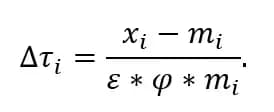"Buy American or pay the price" – that's the stark reality facing markets after President Trump's sweeping "Liberation Day" tariffs upended global trade on 2 April 2025. With tariffs reaching as high as 50% on imports from 57 countries and the S&P 500 already down 8%, traders face a new investment landscape where traditional playbooks may no longer apply. As supply chains scramble and inflation fears mount, understanding which sectors will sink or swim could mean the difference between protection and pain for your portfolio.
What Are the Liberation Day Tariffs?
The new tariff structure works on two levels:
First, a universal 10% baseline tariff now applies to almost all U.S. imports, effective 5 April 2025.
Second, "reciprocal" tariffs targeting 57 specific countries took effect 9 April 2025, with rates varying significantly by nation. These country-specific tariffs were calculated using a straightforward but controversial formula:

Tariff Rate (%) = (U.S. Trade Deficit with Country / U.S. Imports from Country) × 0.5
Source: Office of the United States Trade Representative
This formula explains why countries face such different rates:
- China faces a 34% additional tariff (on top of existing 20% tariffs). With a $295 billion trade deficit and $440 billion in imports last year, the math works out to exactly 34%.
- Vietnam's steep 46% tariff reflects its $123.5 billion trade deficit against $136.6 billion in exports to the U.S. – a nearly one-sided trading relationship.
- European Union countries are hit with a 20% tariff, reflecting their collective trade surplus with the U.S.
- Some smaller economies face the maximum 50% rate, like Saint Pierre and Miquelon (a French territory), where the trade deficit nearly equals total imports.
When combined with existing tariffs, some products now face total import duties approaching 80%. Canada and Mexico are exempt from the new reciprocal tariffs but remain subject to previously imposed 25% tariffs.
When combined with existing tariffs, some products now face total import duties approaching 80%. Canada and Mexico are exempt from the new reciprocal tariffs but remain subject to previously imposed 25% tariffs.
Market Impact So Far
Markets have plunged in response to these tariffs, with losses accelerating beyond initial reactions:
The S&P 500 has entered bear market territory, down 14% since the announcement. The Nasdaq has fallen 15%, with supply-chain dependent tech giants leading declines. The Dow has shed over 5,000 points (12%), including a 3.4% single-day drop on Monday. This selloff has erased over $6.6 trillion in equity value in just days.
Bond yields have dropped sharply as recession fears mount. The dollar has weakened against major currencies, while gold has surged as investors seek safety.
Goldman Sachs now predicts U.S. GDP could contract by up to 2.5% in 2025, representing roughly $300 billion in lost output. Inflation is expected to hit 9.5% while wages grow only 8.6%, potentially costing the average U.S. household $3,400-$4,200 in purchasing power annually.
Wall Street has significantly increased recession probability estimates, with many analysts now predicting a downturn by late 2025 if tariffs remain at current levels.
Winners and Losers Across Sectors
Wall Street's initial selloff treated nearly all stocks as equal victims of the tariff tsunami – creating a trader's paradise of mispriced opportunities. The mathematical formula driving these tariffs creates dramatically different outcomes across industries, with some facing existential threats while others stand to capture market share. Smart money is already positioning for this divergence, focusing on three key factors: import dependency, pricing power, and supply chain flexibility. Here's where the battlelines are being drawn:
Sectors Facing Headwinds
Manufacturing companies reliant on imported components are already reporting higher costs and production challenges (E.g. General Electric [GE], Boeing [BA]). Consumer goods retailers will struggle to pass higher costs onto price-sensitive shoppers (E.g. Walmart [WMT], Target [TGT]).
We're already seeing evidence of these pressures, with companies like Cleveland Cliffs [CLF], Stellantis [STLAM], and Whirlpool [WHR] announcing layoffs due to rising input costs and weakening demand.
Sectors with Potential Upside
Domestic automakers and U.S. steelmakers stand out as potential beneficiaries due to their reduced reliance on imports and the protectionist measures favouring local production (E.g. Ford Motor Company [F], General Motors [GM], Nucor Corporation [NUE], United States Steel Corporation [X]).
Defensive stocks such as healthcare companies with substantial domestic operations may weather this storm better, especially those with strong pricing power (E.g. Pfizer [PFE], Gilead Sciences [GILD], Eli Lilly and Co [LLY]).
Financial services firms have less direct exposure to tariffs, though they remain vulnerable to broader economic slowdown. Industrial distribution companies could actually benefit as businesses rebuild domestic supply chains.
Regional Trade Impacts
The U.S. ironically appears likely to be among the hardest-hit economies despite initiating these measures. Goldman Sachs estimates a five-percentage-point increase in tariffs could trim 1-2% from S&P 500 earnings growth.
Asian economies face significant challenges, particularly China and Southeast Asian nations like Vietnam that had previously benefited from supply chain shifts away from China. European nations, already dealing with sluggish growth, now face additional headwinds from the 20% EU tariff.
Actionable Trading Strategies
With this landscape in mind, here are practical investment approaches to consider:
Equity Strategies
U.S. market dominance may be waning after years of outperformance. Consider adding exposure to defensive sectors and domestically focused businesses with limited import dependencies. Look for quality small-cap companies that have been oversold but have resilient business models and minimal trade exposure.
Specific opportunities include:
- Companies involved in domestic supply chain development
- Businesses with essential products and strong pricing power
- Firms with primarily U.S.-based operations and customer bases
Alternative Investments
Consider adding some exposure to gold and other precious metals as a hedge against continued market volatility. For active traders with access to alternative markets, secondary opportunities in private equity may emerge as institutional investors rebalance portfolios.
What to Watch Going Forward
Keep an eye on these key indicators as the situation evolves:
- Potential exemptions or modifications to the tariff formula could emerge following negotiations with trading partners. The administration has signalled willingness to adjust the "halving factor" in the formula (currently 0.5) for countries that make concessions on market access. This creates both risks and opportunities as negotiations unfold.
- Some analysts speculate the minimum 10% threshold could be raised for allies, potentially creating sudden market shifts if implemented. Watch for countries attempting to reduce their calculated tariff rates by quickly increasing purchases of U.S. goods to shrink their bilateral deficits.
- Monitor upcoming earnings reports for sector-specific impacts, particularly guidance related to supply chain disruptions and margin pressures. Pay special attention to companies mentioning shifts in sourcing strategies to exploit regional differences in tariff rates.
- Keep a close eye on inflation data, as this will influence Fed policy decisions and market sentiment. The tariff formula's impact will be felt unevenly across product categories, creating potential trading opportunities in commodities and consumer goods.
Bottom Line for Traders
The Liberation Day tariffs represent a major shift in trade policy that will create both challenges and opportunities. Unlike previous more targeted measures, these comprehensive tariffs have triggered significant market reactions and raised legitimate recession concerns.
Successful trading in this environment requires focusing on companies with pricing power and limited tariff exposure, maintaining balanced exposure across sectors, and staying alert for selective opportunities that emerge from market dislocations.
While volatility will likely persist in the near term, prepared traders who can navigate these choppy waters with discipline and adaptability will find opportunities to protect capital and potentially profit from this evolving trade landscape.
This article is for general information only does not take into account the specific investment objectives, financial situation or particular needs of any person. It is not to be regarded, or construed, as providing any financial, investment or trading advice/recommendation. Trading Contract for Differences ("CFDs") may not be suitable for you. Losses can exceed your deposits. Do note that all forms of trading and investments carry risks and may not suit everyone. Please ensure you understand the risks involved, including the risk of losing your original invested amount. You should consider carefully whether the financial product is suitable for you before investing or trading. See risk warning/disclosure and other important information on our websites at www.cmcmarkets.com.sg and www.cmcinvest.sg. This advertisement has not been reviewed by the Monetary Authority of Singapore.



